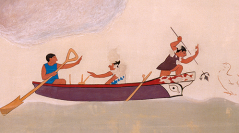

 Anthropozoologica
56 (5) - Pages 71-85
Anthropozoologica
56 (5) - Pages 71-85In northern Italy’s Po Plain, Etruscan cities flourished during the Archaic period (c. 6th-4th centuries BC), thanks to an organized and dynamic commercial network that linked these centres with Italy, Europe, and the Mediterranean. This new urban network had a significant impact on the territory it occupied, and zooarchaeological studies document the emergence of a new agricultural strategy and livestock improvement. While there is ample evidence for how these Etruscan communities shaped their urban environments and agricultural hinterland, their relationship with wild resources – outside of prestige hunting – is poorly understood. As a result of taphonomic and recovery biases, zooarchaeological assemblages representing small wild taxa like fish and birds are rare. In this context, the fish bone assemblage from the Archaic harbour town of Forcello offers an exceptional opportunity to investigate wild resource exploitation in an urban context. Here we present an initial analysis of the ichthyological assemblage and place results in their broader zooarchaeological and cultural context. Results suggest a fishing strategy that privileged large, line-caught fish, with a significant degree of continuity in species representation over pre- and proto-history. While the amount of food furnished by fishing was minimal compared to that from domestic livestock, wild foods including fish were the main source of diversity in the diet: a role which may have influenced their relatively greater visibility in Etruscan ritual practices.
Iron Age, Etruscan, subsistence, palaeoeconomy, biodiversity, Po Plain, fluvial environments